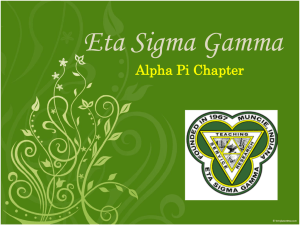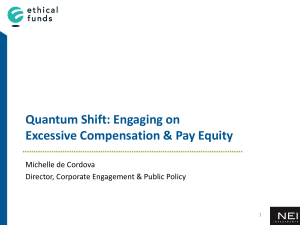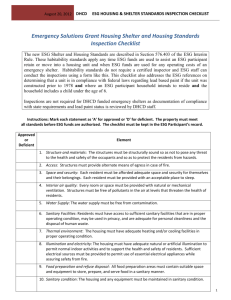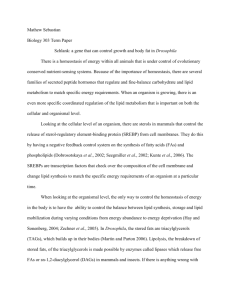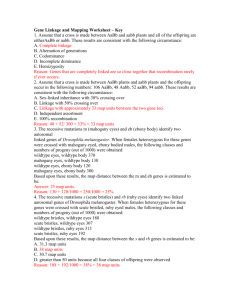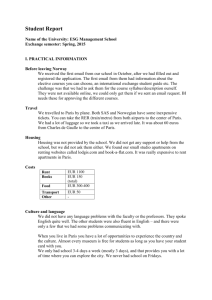Supplementary Information (doc 192K)
advertisement
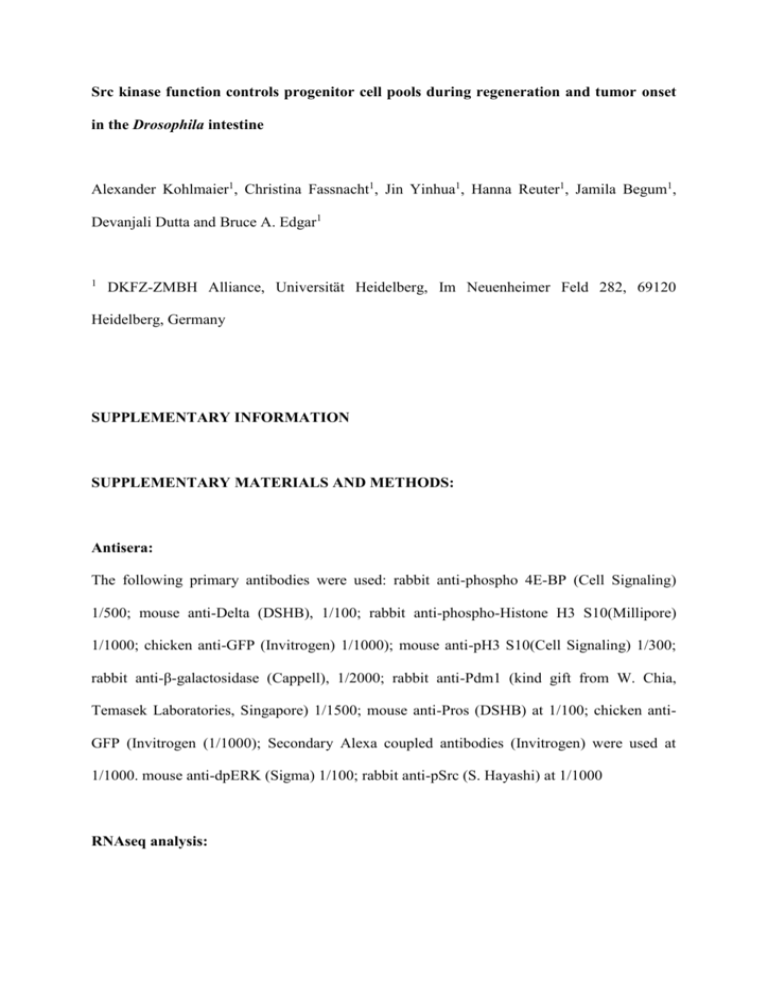
Src kinase function controls progenitor cell pools during regeneration and tumor onset in the Drosophila intestine Alexander Kohlmaier1, Christina Fassnacht1, Jin Yinhua1, Hanna Reuter1, Jamila Begum1, Devanjali Dutta and Bruce A. Edgar1 1 DKFZ-ZMBH Alliance, Universität Heidelberg, Im Neuenheimer Feld 282, 69120 Heidelberg, Germany SUPPLEMENTARY INFORMATION SUPPLEMENTARY MATERIALS AND METHODS: Antisera: The following primary antibodies were used: rabbit anti-phospho 4E-BP (Cell Signaling) 1/500; mouse anti-Delta (DSHB), 1/100; rabbit anti-phospho-Histone H3 S10(Millipore) 1/1000; chicken anti-GFP (Invitrogen) 1/1000); mouse anti-pH3 S10(Cell Signaling) 1/300; rabbit anti-β-galactosidase (Cappell), 1/2000; rabbit anti-Pdm1 (kind gift from W. Chia, Temasek Laboratories, Singapore) 1/1500; mouse anti-Pros (DSHB) at 1/100; chicken antiGFP (Invitrogen (1/1000); Secondary Alexa coupled antibodies (Invitrogen) were used at 1/1000. mouse anti-dpERK (Sigma) 1/100; rabbit anti-pSrc (S. Hayashi) at 1/1000 RNAseq analysis: Total RNA was directly isolated from 20-30 whole midgut tissues of different Src- or Ackexpressing intestines and their respective controls (esgts controls or esgFO control) after 1 week of transgene expression (Suppl. Table 1,2). RNA was isolated with Trizol (Invitrogen) without prior tissue dissociation. For esgFO>Src, esgFO>Ack and esgts>Src expression 6x multiplexed libraries were made and run on an Illumina HiSeq2000 sequencer with 50 bp read length. For esgts and dlts mediated Ack expression, 4x multiplexed libraries were made with the Illumina TruSeq preparation kit from normalized amounts of RNA and run on a GAIIX sequencer with 72 bp read length. 8-14M reads were obtained and 4-8M unique reads mapped and normalized using RPKM normalization. RPKM values for all experimental conditions are presented in the form of log2 transformed normalized expression (N.E.) values in the Suppl. Tables. For esgts >Notch RNAi and the respective esgts control samples (Suppl. Table 1,2), midguts were dissociated with 75μl of 50mg/ml Collagenase for 1 hour at 27°C. 2000 esgGFP+ cells were sorted using a FACS Aria II sorter (BD Biosciences). Total RNA by extraction using the PicoPure RNA isolation kit (Arcturus) resulted in approx. 2ng of RNA. RNA was subsequently linearly amplified (5000x) using the RiboAmp HS PLUS RNA amplification kit (Applied Biosciences). RNA sequencing was performed using an Illumina HiSeq2000 sequencer with 2x multiplexed libraries with 50 bp read length. 35-40M reads were obtained and 15-20M unique reads mapped and normalized using RPM normalization. Samples were analyzed in replicates of three at 95% confidence level. For WT esg+, ISC and EB cell type-specific profiles (Suppl. Fig. S3A) 100 dissected guts were dissociated and 2000 GFP+ cells each were sorted using esg>GFP (progenitors), GbeSu(H)ts>GFP (EBs) or Dlts>GFP (ISCs) cell-type specific Gal4 drivers and analyzed as above. RNA sequencing was performed using an Illumina HiSeq2000 sequencer with 2x multiplexed libraries with 50 bp read length. Data from 3 replicates per genotype were analyzed using DNAStar’s QSeq software. Reads were mapped to the Drosophila melanogaster genome (NCBI release 5.10). Data were analyzed using DNAStar’s QSeq software. The gene set of functional cell cycle regulators analyzed in Suppl. Table 1, 2 was previously assembled1 and imported into QSeq software. No cutoff for minimal expression was applied to exclude weakly expressed genes, because also Delta, the standard marker for stem cells, is weakly expressed in wildtype ISCs. Fly strains: w; MyoIAGal4; tubGal80ts UAS-GFP (myo1ats), yw; esgGal4; tubGal80ts UAS-GFP (esgts), w;esgGal4, tubGal80ts, UAS-GFP; UAS-Flp, Act>CD2>Gal4 (esgFO) have been described previously2. w; Gbe-Su(H)Gal4, UAS-CD8-GFP; tubGal80ts and w;tubGal80ts; UASGFP;DlGal4 were described3. UAS-Src42a.CA, UAS-Src64b, UAS-Mkp3, and the EgfrCO mutant allele were obtained from Bloomington stock center (Bloomington, IN, USA). (MAE)Src64b4 (Fig. 2A, A') was obtained via Leslie Saucedo (University of Puget Sound, Tacoma, USA). UAS-Ack lines were described5 and a kind gift from N. Harden (Simon Fraser University Burnaby, British Columbia, CA), Su(H)Gbe-LacZ was a kind gift from S. Bray (University of Cambridge, UK), the DeltaGal4 and Gbe-Su(H)Gal4 lines were kind gifts from S. Hou (NIH Frederick, Maryland, USA). The bantam microRNA GFP sensor lines was a kind gift from M. Milan (IRB Barcelona, ESP), Pon-GFP line was a kind gift from Y.-N. Jan (HHMI UCSF, USA). stg::GFP and cycB3::GFP trap lines were from the Yale Flytrap consortium (USA), the STAT-GFP6 ([BAC CH321-73F24 P[acman] line was a gift from Sol Sotillos (CABD, Sevilla, ESP). UAS-Src42a30-1, UAS-Src42a43-3, UAS-Src64bYF42(constitut. act.), UAS-Src64b9-2 were all kind gifts from Tian Xu7 (Yale, School of Medicine, USA). UAS-DomeCyt and UAS-DomeCyt8 were obtained via Parthive Patel from James Castelli-Gair Hombría (CAPD, Sevilla, ESP). RNAi lines were obtained from Vienna Drosophila VDRC RNAi or the TRIP RNAi Stock Centers: Src42a RNAi (VDRC GD10610 v26019), Src64b RNAi (VDRC GC12263 v35252), Notch RNAi (v27228), PS3/4 RNAi (VDRC v4891) targeting CG8095 (PS3) and with 4/270 19-mer hits also CG16827 (PS4), aPKC (VDRC v2907), UAS-stg, UAS-cycE, UAS-E2f1, UAS-Dp and UAS-Cdk2 and their combinations were reported9, Egfr RNAi and Stat92E RNAi flies published2, 10. UAS-rca1 and UAS-fzr lines were reported11-13. Flies were maintained on standard media, only female flies were analysed. 1 Guest ST, Yu J, Liu D, Hines JA, Kashat MA, Finley RL, Jr. A protein network-guided screen for cell cycle regulators in Drosophila. BMC Syst Biol 2011; 5: 65. 2 Jiang H, Patel PH, Kohlmaier A, Grenley MO, McEwen DG, Edgar BA. Cytokine/Jak/Stat signaling mediates regeneration and homeostasis in the Drosophila midgut. Cell 2009; 137: 1343-1355. 3 Zeng X, Chauhan C, Hou SX. Characterization of midgut stem cell- and enteroblastspecific Gal4 lines in drosophila. Genesis 2010; 48: 607-611. 4 Pagarigan KT, Bunn BW, Goodchild J, Rahe TK, Weis JF, Saucedo LJ. Drosophila PRL-1 is a growth inhibitor that counteracts the function of the Src oncogene. PLoS One 2013; 8: e61084. 5 Zahedi B, Shen W, Xu X, Chen X, Mahey M, Harden N. Leading edge-secreted Dpp cooperates with ACK-dependent signaling from the amnioserosa to regulate myosin levels during dorsal closure. Dev Dyn 2008; 237: 2936-2946. 6 Sotillos S, Krahn M, Espinosa-Vazquez JM, Hombria JC. Src kinases mediate the interaction of the apical determinant Bazooka/PAR3 with STAT92E and increase signalling efficiency in Drosophila ectodermal cells. Development 2013; 140: 1507-1516. 7 Pedraza LG, Stewart RA, Li DM, Xu T. Drosophila Src-family kinases function with Csk to regulate cell proliferation and apoptosis. Oncogene 2004; 23: 4754-4762. 8 Brown S, Hu N, Hombria JC. Identification of the first invertebrate interleukin JAK/STAT receptor, the Drosophila gene domeless. Curr Biol 2001; 11: 17001705. 9 Buttitta LA, Katzaroff AJ, Perez CL, de la Cruz A, Edgar BA. A double-assurance mechanism controls cell cycle exit upon terminal differentiation in Drosophila. Dev Cell 2007; 12: 631-643. 10 Jiang H, Grenley MO, Bravo MJ, Blumhagen RZ, Edgar BA. EGFR/Ras/MAPK signaling mediates adult midgut epithelial homeostasis and regeneration in Drosophila. Cell Stem Cell 2011; 8: 84-95. 11 Zielke N, Querings S, Grosskortenhaus R, Reis T, Sprenger F. Molecular dissection of the APC/C inhibitor Rca1 shows a novel F-box-dependent function. EMBO Rep 2006; 7: 1266-1272. 12 Sigrist SJ, Lehner CF. Drosophila fizzy-related down-regulates mitotic cyclins and is required for cell proliferation arrest and entry into endocycles. Cell 1997; 90: 671-681. 13 Grosskortenhaus R, Sprenger F. Rca1 inhibits APC-Cdh1(Fzr) and is required to prevent cyclin degradation in G2. Dev Cell 2002; 2: 29-40. 14 Buchon N, Broderick NA, Kuraishi T, Lemaitre B. Drosophila EGFR pathway coordinates stem cell proliferation and gut remodeling following infection. BMC Biol 2010; 8: 152. 15 Shindo M, Wada H, Kaido M, Tateno M, Aigaki T, Tsuda L et al. Dual function of Src in the maintenance of adherens junctions during tracheal epithelial morphogenesis. Development 2008; 135: 1355-1364. 16 Brennecke J, Hipfner DR, Stark A, Russell RB, Cohen SM. bantam encodes a developmentally regulated microRNA that controls cell proliferation and regulates the proapoptotic gene hid in Drosophila. Cell 2003; 113: 25-36. SUPPLEMENTARY FIGURE LEGEND Suppl. Figure S1 Src levels determine progenitor proliferation capacity (A) Conditional Src kinase expression in esg+ progenitors for 7 days triggers progenitor division and esg+ progenitor pool size increase. Note that wildtype stem cell nests contain 1-3 esg+ cells. 6-8 esg+ cells are observed per stem cell nest following Src64b expression. Amplified esg+ cells following Src42a.CA expression cover the intestinal epithelium. Some surplus esg+ cells following Src kinase expression are diploid, while some show ectopic endoreplication. Zoom-in (right panels). (B) Overexpression of different transgenic alleles of Src64b or Src42a in esg+ cells for 1 day, including the constitutively active mutant Src64bYF42 and wildtype Src64b9-2, wildtype Src42a30-1 and wildtype Src42a43-3 alleles. All these alleles have been classified as exhibiting moderate (M) or strong (S) mutant tissue growth phenotypes when expressed with GMR-GAL4 drivers in larval eye imaginal discs7. Overexpression of moderate Src42a alleles stimulates ISC division more strongly than strong or constitutively active Src64b alleles. (B') Real-time PCR analysis. mRNA abundance of selected cycle regulators cyclin A, cyclin B, string, of escargot and of stress-related cytokines rhomboid and spaetzle following 1 day pulse-expression of Src42a.CA, Src64b or Ack in esg+ cells. (B'') Src64b expression in ECs triggers EC delamination from the basement membrane into the intestinal lumen more strongly than Src42a.CA overexpression. This was judged from a decrease of midgut longitudinal and circumferential extensions, which is known to be due to available EC numbers14. (C) esgFO-Gal4-mediated clonal labelling of esg+ progenitors and their progeny for 2 days shows that expression of Src42a.CA or of Src64b causes progenitor cell overproliferation (non-overlapping GFP+ clones marked by dotted line). Zoom-in of boxed area in the right panels. pERK staining (extracellular signal-regulated kinase) marks ERK MAPK signaling activity and distinguishes undifferentiated progenitors from differentiated cells. Extra cells produced by Src kinases activation maintain pERK activity in many accumulating cells. Suppl. Figure S2 Src kinases are required for esg+ progenitor cell proliferation rate (A) Co-depletion of Src42a and Src64b in esg+ cells for 14 days (at 29°C) causes a reduction in the number of esg+ marked progenitor cells. Since ISCs (marked with Delta) are still detectable, this reduction is due to impaired replenishment of differentiating EBs by regenerative division of ISC division. (B) Src42a or Src64b inhibition by trangenic RNAi (IR) for 7 days triggers reduction of DNA replication capacity in esg+ progenitors. FACS analysis of DNA content. Note reduced numbers of progenitors in S-phase following Src42a depletion during P.e. infection-mediated tissue regeneration (middle panel, red trace) compared to infected wildtype controls (left panel, red trace). For reference, red dashed horizontal line marks S-phase levels in P.e. infected wildtype. After Src42a depletion reduced numbers of diploid nuclei and increased numbers of endoreplicative nuclei are observed in uninfected esg+ cells (middle panel, black trace) compared to uninfected wildtype progenitors (left panel black trace). (C) EsgFO-mediated Src42a depletion for 7 days does not lead to ISC differentiation. Red arrows indicate remaining weak endocytic Delta foci marking ISCs, which are display reduced p4E-BP levels, a Notch-signaling activity-dependent marker of undifferentiated ISCs. (C') Prolonged Src42a depletion for 28 days does not trigger differentiation of ISCs, as judged from absence of absence of Gbe-Su(H)-LacZ levels, a transcriptional reporter for Notch signaling activity. (D) Levels and distribution of phosphorylated active Src42a (pSrc42aY40015) in healthy wildtype and P.e. infected midguts. Suppl. Figure S3 Asymmetric ISC division following core cell cycle stimulation (A) pERK signaling strength per individual cell was not increased upon Src42a.CA or Src64b activation compared to controls. Quantification of mean nuclear pERK intensity per individual cell plotted in arbitrary units (a.u.) after normalization to the mean nuclear escargot-GFP intensity within a cell. Each bar represents one cell, values were ranked from low to high. (A') Endogenous STAT92E protein levels and distribution, as reported from a STAT92E-GFP BAC transgene, in healthy wildtype or following Src42a.CA expression in esg+ progenitors. White arrow mark diploid esg+ progenitors, and red arrows mark aberrant endoreplicating esg+ cells. (B) String (Stg), Cyclin E (CycE), E2F1/Dp were expressed alone or in combination with Cdk2, as indicated, in Delta+ ISCs or Gbe-Su(H)+ EBs. Mitotic rates were measured. For E2F1/Dp expression in EBs the numbers of total mitoses per midgut and, separately, of mitoses within GFP-marked EBs were plotted. Note that E2f1, Dp;CycE;Cdk2 coexpression triggered much higher levels of mitoses and that data were plotted on a different scale. (C) Different classes of esg+ progenitor cell clusters form following co-expression of Stg and CycE in esg+ cells. Gbe-Su(H)-LacZ levels report Notch activity in the history of these cells: note rare clusters that are Notch-negative (outlined with white dotted line), as well as clusters with weak Notch levels or containing several distinctly Notch positive cells (orange) and frequent clusters containing mostly Notch positive cells (red). (C') Mitotic cell cycle stimulation by E2f1 + Dp co-expression for 4 days in ISC by MARCM clonal analysis reveals amplification of Notch-positive (Gbe-Su(H)+) EBs (red arrows) and maintenance of a single Notch-negative bona fide ISCs (white arrow). Suppl. Figure S4 Ack kinase expression triggers amplification of a specified progenitor cell type Ack overexpression leads to particularly strong amplification of Dl+ cells. We tested whether these Ack-expressing Dl+ cells represented ISC-like cells by expression profiling. (A) We established wildtype ‘ISC-selective’ and wildtype ‘EB-selective’ RNA-seq expression signatures, by comparison of FACS-sorted wildtype ISCs with sorted wildtype EBs in triplicates at 95% confidence. These profiles were compared to the profile of whole midgut tissues consisting mostly of esg+ progenitors, many of which where Dl+, after 1 week of Ackoverexpression. The mRNA expression profile of midguts following Ack expression in esg+ progenitors for 7 days (cutoff=2x differential expression) is more similar to the expression profile of FACS-sorted wildtype enteroblasts than to FACS-sorted wildtype ISCs. No cutoff for minimal normalized expression level was applied to exclude any weakly expressed genes, because also Delta, the standard marker for stem cells, is weakly expressed in uninfectd wildtype progenitor cells. EB-selective and ISC-selective expression profiles were determined by comparison of wildtype EB with ISC profiles at 2-fold or 10-fold differential upregulation (top) or downregulation (bottom). See Suppl. Materials and Methods for determination of ISC- and EB selective profiles. (B) Bantam microRNA displays higher activity in ISCs (red arrow) and reduced activity in differentiated ISC daughter cells (white dashed arrows, left panel) using a transgenic Tub-GFP reporter controlled by two 31 nucleotide long bantam micro RNA target sites integrated in the 3'UTR of the P element in the CaSpeR4 transgenesis vector16. Ack expression for 7 days can amplify the number of cells with high bantam activity (red arrows). Suppl. Figure S5 Molecular control of the mitotic-to-endocycle switch in the intestine (A-C') APC/C activity levels control maintenance of diploid esg+ progenitor cell fate. (A) Cyclin B3 is not degraded in differentiating ISC daughter cells residing in one stem cell nest (preplicating ISCs are marked by EdU labelling, red arrow). (B) Rca1 overexpression inhibits mitotic-to-endocycle switching in progenitors as well as impairs the maturation of differentiating EBs to Pdm1+ ECs compared to esgFO controls of the same age. Note Pdm1 staining in mature EC derived from ISC division within 12 days in the wildtype (white arrows). Nuclear Pdm1 staining is absent in arrested GFP+ cells following Rca1 expression (yellow dashed arrows). (C) Fzr expression stimulates formation of high rates of endoreplication in wildtype esg+ cells and reduces esg+ progenitor overproliferation triggered by Notch depletion when Fzr is coexpressed with the Notch RNAi constructs. In this case, Fzr decreases the number of ectopic EEs following Notch depletion, at least in part by causing aberrant endoreplication in diploid Prospero-marked EEs. (C'). Zoom-in of C: Fzr overexpression reduces EE cluster formation of Notch-depleted progenitors. Arrow marks ectopic endoreplication in a Notch-depleted Prospero marked EE. Suppl. Table 1 Src kinases expression levels in wildtype intestinal cell types after P.e. infection Numbers represent fold-change (up or down as indicated) in mRNA abundance of P.e. infected adult intestinal cell types compared to healthy wildtype counterparts. For RNAseq analysis, esgGFP-labeled progenitors, or Delta-GFP labeled ISCS, or Gbe-Su(H)-GFP labeled EBs were FACS-sorted. Suppl. Table 2 List of induced cell cycle regulators following Src42a or Ack expression or Notch inhibition. Ack or Src42a.Ca kinases were expressed using either the esgts flipout (esgFO) system2 for permanently marking ISCs and their progeny or esg-Gal4 expression (esgts) for progenitorspecific gene expression affecting ISCs and their EB daughters. Numbers represent foldchange increase in mRNA abundance of functional cell cycle regulators compared to esgFO or esgts controls, respectively. The list was ranked by highest upregulation following esgFO>Src42a.CA expression. Transgenes were induced for 7 days. Asterisks indicate direct E2F1 targets. The cut-off value was 2.0 fold increase of mRNA abundance. The genes in this list were independently determined to be expressed in wildtype intestinal progenitor cell types: following tissue dissociation and FACS sorting of wildtype esg-GFP+ cells, or wildtype dl-GFP+ cells or wildtype Gbe-Su(H)-GFP+ cells, a log2 normalized expression (N.E) value >1.000 in either sorted esg+ progenitors, or sorted Dl+ ISCs or sorted Notch+ EBs was applied as cutoff for a factor to be included in this analysis. N.E values represent log2 transformed RPKM values (See Suppl. Materials and Methods for details). Suppl. Table 3 Normalized expression values of cell cycle regulators listed in Suppl. Table 1 The N.E. values (log2 transformed RPKM values) of cell cycle regulators found to be commonly induced following Src42a.CA or Ack expression or Notch inhibition (Suppl. table 2) are listed. Different samples were prepared independently on different Illumina platforms (Hiseq2000 or GAIIX as indicated), and should be quantitatively compared only to their respective controls (boxed) and not between each other.


